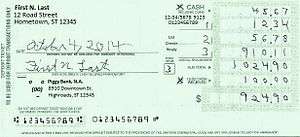Deposit slip
A deposit slip is a form supplied by a bank for a depositor to fill out, designed to document in categories the items included in the deposit transaction. The categories include type of item, and if it is a cheque, where it is from such as a local bank or a state if the bank is not local. The teller keeps the deposit slip along with the deposit (cash and cheques), and provides the depositor with a receipt. They are filled in a store and not a bank, so it is very convenient in paying. They also are a means of transport of money.[1][2][3] Pay-in slips encourage the sorting of cash and coins, are filled in and signed by the person who deposited the money, and some tear off from a record that is also filled in by the depositor.[4][5] Deposit slips are also called deposit tickets and come in a variety of designs. They are signed by the depositor if the depositor is cashing some of the accompanying check and depositing the rest.[6][7]

Cash received
On a deposit slip, "cash received" means that part of the amount on a cheque that is to be withdrawn as cash. The remainder is deposited into the person's account.[8]
Completion of slips
The description column on deposit slips has been used for over 100 years in the U.S. to notate where the bank should send the check to reclaim the money; this was done at first by notating in words the name of bank or its location.[9] The bank's transit number, also called bank number, began to be used instead of words.[10][11][12] The bank number was written as the upper line of a fraction, with the bottom number referring to the central bank branch. Some people wrote just the top of the fraction, others tried writing the entire fraction.[13][14] After the introduction of automated sorting of checks, many people wrote nothing at all in the deposit slip's description column.[15][16][17] Some people put the check writers' names in the description column.[18][19] There was a tendency in the early teens of the 21st century to write in the number of the check being deposited without mentioning who the check was from.[20]
See also
- Passbook
- Bank statement
- Cheque book
- Deposit account
References
- "Business forms and financial institutions", by Franklin Reinhardt Heath Google Books
- "Elements of Bookkeeping": Ferris Institute, Big Rapids, Michigan Google Books
- "Student's Guide to Accompany the Ellis Cabinet System of Teaching ...", by Charles L. Ellis Google Books
- Paying money into the bank, Money Matters to Me: National Institute of Adult Continuing Education (England & Wales)
- Hong Kong and Shanghai Banking Corporation. 2014. Paying-in slips
- Reihl, Charles W. 1904. A Study of Deposit Slips. The Bankers Magazine, Volume 68, Page 643. New York, NY: The Bankers' Publishing Company. Google eBook
- Wells Fargo Bank. 2014. Your New Checking Account Getting Started Guide, page 4.
- Hands on Banking Program for Teens, Savings and Checking Guide, Lesson 5: Making a Savings Account Deposit.
- Eaton, Seymour. 1896. "How to Do Business as Business is Done in Great Commercial Centers", Page 12. Philadelphia, PA: P. W. Ziegler & Co. Google eBook
- "Elementary Banking", by American Institute of Banking, 1922 page 63
- "The Office: Procedures and Technology", by Mary Ellen Oliverio, William R. Pasewark, Bonnie R. White. page 240 Cengage Learning, Mar 14, 2012
- "College Accounting", by James Heintz, Robert Parry Page 231 Cengage Learning, Jan 15, 2010.
- "Business Skills Exercises", by Loretta Barker. page 88 Cengage Learning, Feb 15, 2012
- "Money Sense for Kids", by Hollis Page Harman page 90 Barron's Educational Series, 2004
- "Contemporary Mathematics for Business and Consumers", by Robert Brechner page 98 Cengage Learning, Feb 28, 2011
- hsbc.co.uk "Paying-in slips", The Hong Kong and Shanghai Banking Corporation Limited
- moneymatterstome.co.uk "Paying money into the bank", Leicester LE1 7GE: National Institute of Adult Continuing Education
- "FCS Applied Accounting L2", by Irene Stotko & Linda Botha page 6 Pearson, South Africa
- "Kinn's The Administrative Medical Assistant: An Applied Learning Approach", by Elsevier Health Sciences, Nov 28, 2013 page 438 Elsevier Health Sciences
- "Hands on Banking for Young Adults, Getting Started, Lesson 5" "How to fill in a deposit slip".